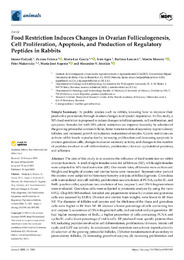Por favor, use este identificador para citar o enlazar este ítem:
https://hdl.handle.net/11000/36551Registro completo de metadatos
| Campo DC | Valor | Lengua/Idioma |
|---|---|---|
| dc.contributor.author | Hadjadj, Imane | - |
| dc.contributor.author | Fabova, Zuzana | - |
| dc.contributor.author | Garcia Pardo, Maria Luz | - |
| dc.contributor.author | Agea, Iván | - |
| dc.contributor.author | Loncová, Barbora | - |
| dc.contributor.author | Morovic, Martin | - |
| dc.contributor.author | Makovicky, Peter | - |
| dc.contributor.author | Argente, María José | - |
| dc.contributor.author | Sirotkin, Alexander V. | - |
| dc.contributor.other | Departamentos de la UMH::Tecnología Agroalimentaria | es_ES |
| dc.date.accessioned | 2025-05-02T09:59:13Z | - |
| dc.date.available | 2025-05-02T09:59:13Z | - |
| dc.date.created | 2025-02 | - |
| dc.identifier.citation | Animals 2025, 15(9), 1282 | es_ES |
| dc.identifier.issn | 2076-2615 | - |
| dc.identifier.uri | https://hdl.handle.net/11000/36551 | - |
| dc.description.abstract | The aim of this study is to examine the influence of food restriction on rabbit ovarian functions. A total of eight females were fed ad libitum (NF), while eight females were subjected to 50% food restriction (RF). One month later, all females were euthanized. Weights and lengths of ovaries and uterine horns were measured. Representative parts of the ovaries were subjected to histomorphometry analysis of folliculogenesis. Granulosa cells were isolated and cell viability, proliferation (accumulation of PCNA, cyclin B1, and BrdU-positive cells), apoptosis (accumulation of bax, caspase 3, and DNA fragmentation) were evaluated. Granulosa cells were subjected to proteomic analysis by using the nano HPLC-Chip-MS/MS method. Estradiol and progesterone release by ovarian and granulosa cells was assessed by ELISA. Ovarian and uterine horn weights were lower in RF than NF. The diameter of follicles and oocytes and the thickness of the theca and granulosa cells were higher in RF than NF. RF showed a lower percentage of cells containing bax and caspase 3, occurrence of DNA fragmented cells, and estradiol and progesterone. RF had higher incorporation of BrdU, a higher proportion of cells containing PCNA and cyclin B1, and a lower percentage of viable cells. RF produced more specific proteins than NF, including peptides involved in cell differentiation, proliferation/division, mitotic cell cycle, and GTP-ase activity. In conclusion, food restriction can activate reproduction by (1) selection of the growing primordial follicles, (2) better transformation of secondary to preovulatory follicles, (3) increasing growth of oocytes, (4) increasing proliferation and decreasing apoptosis in granulosa cells, (5) changes in ovarian secretory activity, and (6) changes in the number of peptides. | es_ES |
| dc.format | application/pdf | es_ES |
| dc.format.extent | 19 | es_ES |
| dc.language.iso | eng | es_ES |
| dc.publisher | MDPI | es_ES |
| dc.rights | info:eu-repo/semantics/openAccess | es_ES |
| dc.rights.uri | http://creativecommons.org/licenses/by-nc-nd/4.0/ | * |
| dc.subject | food restriction | es_ES |
| dc.subject | apoptosis | es_ES |
| dc.subject | hormone | es_ES |
| dc.subject | ovarian follicle | es_ES |
| dc.subject | rabbit | es_ES |
| dc.title | Food Restriction Induces Changes in Ovarian Folliculogenesis, Cell Proliferation, Apoptosis, and Production of Regulatory Peptides in Rabbits | es_ES |
| dc.type | info:eu-repo/semantics/article | es_ES |
| dc.relation.publisherversion | https://doi.org/10.3390/ani15091282 | es_ES |

Ver/Abrir:
animals-15-01282.pdf
2,84 MB
Adobe PDF
Compartir:
 La licencia se describe como: Atribución-NonComercial-NoDerivada 4.0 Internacional.
La licencia se describe como: Atribución-NonComercial-NoDerivada 4.0 Internacional.
.png)